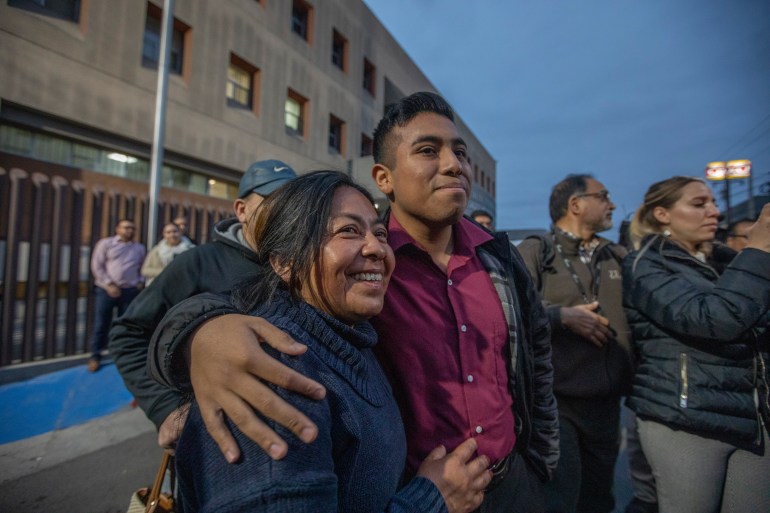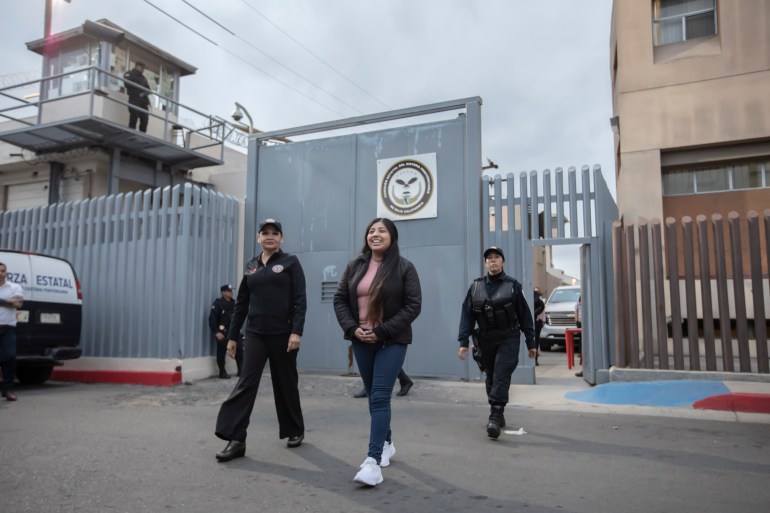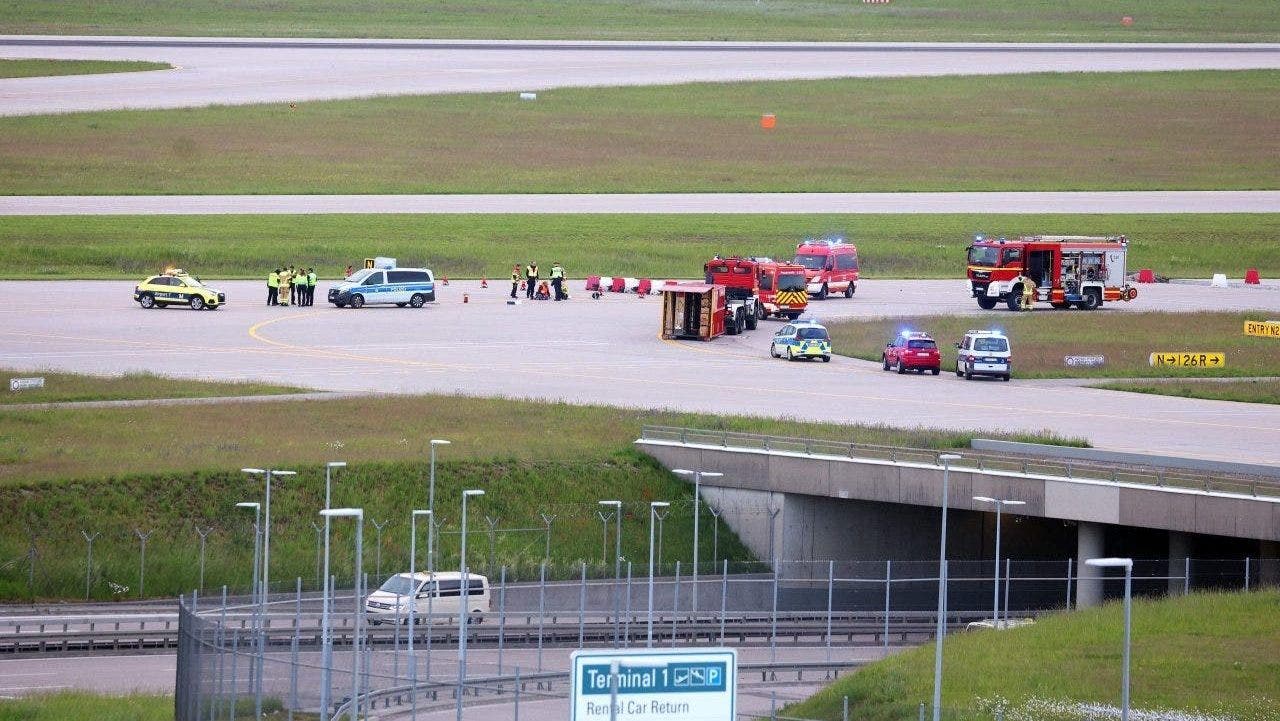World
She awoke to a gun in her face. What happened next would change Mexican law

Tijuana, Mexico – On the evening of December 12, 2019, as Alina Narciso was falling asleep in her home in Tijuana, Mexico, she remembers hearing her boyfriend Luis Rodrigo Juarez snorting cocaine.
Hours later, she was awoken by a gun to her head. It was Juarez, asking her if she “was going to leave him again”.
“One hand was enough for him to beat me in strength, and drunk and drugged, I thought: I don’t have a chance against him,” Narciso, now 28, told Al Jazeera.
What happened next would raise questions about self-defence law in Mexico — and reshape how the criminal justice system in the state of Baja California assesses gender-based violence.
Both Narciso and Juarez were police officers: They met through work when Narciso was only 22.
But from the very beginning, Narciso said Juarez was extremely controlling: “He wanted us to be together all the time.” He also could be violent: According to Narciso, he had sexually abused her and threatened her life on multiple occasions.
Narciso had tried to leave several times, but Juarez always promised to change. He would stop drinking and seek psychological help, she remembers him telling her in a bid to make her stay.
She said they had been discussing those broken promises on December 12. To avoid an argument, Narciso decided to go to sleep. Juarez had been drinking for hours that day.
But the barrel of the gun jolted her awake. Narciso said she tried to escape, but Juarez would not let her. He holstered his weapon and began to beat her furiously, pulling her hair, smashing her face against a door frame and grabbing her by the neck.
In the struggle, Narciso said she managed to grab the firearm.
“There was no chance of me getting out of there alive,” she remembers thinking. As Juarez came towards her, she closed her eyes and fired six shots.
A lengthy sentence
Socorro Tehuaxtle, Narciso’s mother, lived next door. Hearing the gunshots and her daughter’s cries, she ran over to see what the trouble was.
But when she arrived, Juarez was already dead. Tehuaxtle told her daughter to call the police.
Some of the officers who arrived were colleagues, and at first, Narciso thought they would understand her situation. It quickly became clear, however, that they did not see her as a victim forced to defend herself. Rather, she was a suspect.
One even asked her why she had fired so many bullets, Narciso later testified. He reminded her that Juarez had been a friend.
Narciso spent the next three years in pre-trial detention. When her case finally came before the court of Judge Daniel Aguilar Patino, she tried to explain her history of abuse.
While Narciso had never filed a formal police report, she had told colleagues about Juarez’s violence and even enlisted a police unit once to protect her while she attempted to move out.
But even then, she told the judge, Juarez had managed to get past the blockade and inside the house. The police, Juarez indicated, were on his side.
“That guy down there is my friend,” she remembers him saying, referencing the police guard. “Do you think he is going to help you?”
Other officers, however, testified during the trial that Juarez had acted violently with suspects. The defence also presented evidence that Narciso had been bruised in her altercations with Juarez.
But in October 2022, the judge rejected the allegation that Narciso’s life had been in danger. In his ruling, Patino found Narciso’s reaction to Juarez’s attack “excessive”. He said the evidence her lawyer presented was not enough “to cast doubt” on her guilt.
Patino ultimately sentenced Narciso to 45 years in prison for aggravated homicide, a term much longer than some sentences in Baja California for femicide.

‘A circle of violence’
Researchers have found that powerful biases can shape the outcome of self-defence cases, particularly when women allege intimate partner violence.
Many misconceptions revolve around the belief that women can simply leave the relationship to avoid violence. Narciso herself has had to address that belief.
“You don’t realize that you are in a circle of violence,” she explained. “Your brain normalises the situation.”
Other misconceptions downplay how imminent or serious the threat of intimate partner violence can be.
One 2012 study from the United States found that, in a mock trial, 62 percent of participants said they would convict a “battered woman” in a self-defence case because they felt she should have found alternatives to homicide.
Courtroom biases against women can also be amplified when other factors are involved, Tijuana-based researcher Melina Amao told Al Jazeera.
“The criminal justice system has a racial and social class bias,” she said. “The burden in the justice system falls on the most vulnerable people, as exemplary sentences are given to people who have the least possibility of defending themselves.”
Narciso’s mother, Tehuaxtle, remembers feeling intimidated by the judge and some of the jargon he used. “I could not answer some of his questions because I didn’t understand. He repeated them using the same words. He was supposed to speak to me clearly, with an easy vocabulary.”
In Mexico, the prevalence of gender-based violence is high. A survey from the National Institute of Statistics and Geography (INEGI), a government agency, found that 70 percent of all women had experienced violence, whether physical or psychological.

A campaign for freedom
Faced with the prospect of her daughter being imprisoned for decades, Tehuaxtle began to campaign for her release.
Tehuaxtle talked to the media, women’s organisations, and human rights lawyers including Meritxell Calderon, who started to volunteer on the case.
Calderon believes Judge Patino’s actions speak to a larger lack of awareness among judges and prosecutors. “Many of the people who train public servants are the same people who have not updated their knowledge on women’s human rights issues,” she said.
Ultimately, Narciso and her lawyer filed an appeal on October 25, 2022, on the basis that the court had not taken into account her history of abuse with Juarez.
Narciso’s lawyer argued that her claim of self-defence needed to be evaluated through the lens of gender-based violence.
The case gained widespread attention, thanks in no small part to Tehuaxtle’s advocacy work. The state governor of Baja California, Marina del Pilar, and congresswoman Michel Sanchez Allende both offered their support, and feminist groups helped raise awareness for Narciso’s appeal.
Six months later, in May, the appeals court ruled in Narciso’s favour. It declared that she had indeed acted in self-defence, calling her actions “necessary” for her safety.
In addition, the court sanctioned the judge who originally sentenced her to prison, Patino. He was ordered to take training courses in “gender perspective”, a term used in Mexico for the consideration and study of gender discrimination and social roles.

Pushing for systemic change
After years in detention, Narciso was finally free. But her fight did not end there.
Since her appeal, Narciso has continued to combat the legal system — to push for intimate partner violence to be considered in cases of lethal self-defence.
On August 24, a law named in her honour passed unanimously in the Baja California legislature, with 22 votes in favour and one abstention.
Sponsored by congresswoman Sanchez, the Alina Law reforms the state’s penal code, requiring judges and prosecutors to take into account gender, abuse and intimate partner violence when weighing self-defence cases.
But there is still a long way to go to combat stereotypes around intimate partner violence, according to Miguel Mora, the president of the Human Rights Commission of Baja California.
“We cannot yet speak of a process of institution building, nor the application of justice, with a true gender perspective,” Mora said.
He believes a more holistic reform is required to address bias throughout the criminal justice system: from the police on the street up to the highest judges.
As for Narciso and her family, they are still recovering from the trauma of their ordeal.
“The state caused us irreversible damage,” Tehuaxtle said. “We are still suffering the consequences.”

World
Climate activists glue themselves to Munich airport runway, pausing traffic

A group of climate protesters have been arrested in Germany after breaking into an airport and gluing themselves to the runway.
Six activists broke through security fencing at Munich airport in the German state of Bavaria on Saturday, according to the news outlet dpa.
Approximately sixty flights were canceled after the half-dozen protesters glued themselves to the tarmac, forcing officials to temporarily close the airport.
CLIMATE ACTIVISTS ARRESTED FOR BLOCKING AIRSTRIP IN MASSACHUSETTS
Climate activists lie on an access road for runways at the Munich airport. German officials and local media say authorities closed down Munich airport temporarily after six climate activists broke through a security fence and glued themselves to access routes leading to runways. ( (Karl-Josef Hildenbrand/dpa via AP))
An additional fourteen flights into Munich were forced to divert to other nearby airports to avoid the disruption.
Climate protest coalition Last Generation took credit for the stunt, claiming it was intended to draw attention to the German government’s inaction on the airline industry’s environmental impact.
CLIMATE GROUP TAKES RESPONSIBILITY FOR US OPEN CHAOS, OFFERS WARNING: ‘NO TENNIS ON A DEAD PLANET’

Climate activists stuck to a runway access road at Franz-Josef-Strauß Airport early Saturday morning. Climate protection activists paralyzed Munich Airport after breaking into the inner area of the airport grounds. The activists from the group Last Generation were protesting flying, the most polluting form of transportation, said the German news agency dpa on Saturday. (Karl-Josef Hildenbrand/picture alliance via Getty Images)
All six protesters were arrested and charged by law enforcement.
“Trespassing in the aviation security area is no trivial offense. Over hundreds of thousands of passengers were prevented from a relaxed and punctual start to their Pentecost holiday,” German Airports Association General Manager Ralph Beisel told dpa.

Police and firefighters stand on a runway access road at Franz-Josef-Strauß Airport around climate activists who have stuck themselves there. According to their own statements, members of the so-called Last Generation had planned to enter the airport grounds in order to block at least one of the two runways. (Photo: Karl-Josef Hildenbrand/dpa (Photo by Karl-Josef Hildenbrand/picture alliance via Getty Images))
“Such criminal actions threaten air traffic and harm climate protection because they only cause lack of understanding and anger,” German Interior Minister Nancy Faeser wrote about the protests on social media platform X.
The Munich incident was just one of many similar protests around the world against air transportation. Last Generation has performed at least two similar airport disruptions in Germany since last year.
World
Russian court seizes two European banks’ assets amid Western sanctions

Freezing hundreds of billions of dollars in lenders’ assets was part of dispute over gas project halted by sanctions.
A Russian court has ordered the seizure of the assets, accounts, property and shares of Deutsche Bank and Commerzbank in the country as part of a lawsuit involving the German banks, court documents showed.
The banks are among the guarantor lenders under a contract for the construction of a gas processing plant in Russia with the German company Linde. The project was terminated due to Western sanctions.
European banks have largely exited Russia after Moscow launched its offensive on Ukraine in 2022.
A court in St Petersburg ruled in favour of seizing 239 million euros ($260m) from Deutsche Bank, documents dated May 16 showed.
Deutsche Bank in Frankfurt said it had already provisioned about 260 million euros ($283m) for the case.
“We will need to see how this claim is implemented by the Russian courts and assess the immediate operational impact in Russia,” the bank added in a statement.
The court also seized the assets of Commerzbank, another German financial institution, worth 93.7 million euros ($101.85m) as well as securities and the bank’s building in central Moscow.
The bank is yet to comment on the case.
In a parallel lawsuit on Friday, the Russian court also ordered UniCredit’s assets, accounts and property, as well as shares in two subsidiaries, to be seized. The ruling covered 462.7 million euros ($503m) in assets.
UniCredit said it “has been made aware” of the decision and was “reviewing” the situation in detail. The bank was one of the most exposed European banks when Moscow launched its invasion of Ukraine, with a large local subsidiary operating in Russia.
It began preliminary discussions on a sale last year, but the talks have not advanced. Chief executive Andrea Orcel said UniCredit wants to leave Russia, but added that gifting an operation worth three billion euros ($3.3bn) was not a good way to respect the spirit of Western sanctions on Moscow over the conflict.
Russia has faced heavy Western sanctions, including on its banking sector, since the start of the war in Ukraine. Dozens of US and European companies have also stopped doing business in the country.
World
Ukraine's divisive mobilization law comes into force as a new Russian push strains front-line troops
KYIV, Ukraine (AP) — A divisive mobilization law in Ukraine came into force on Saturday, as Kyiv struggles to boost troop numbers after Russia launched a new offensive that some fear could close in on Ukraine’s second-largest city.
The legislation, which was watered down from its original draft, will make it easier to identify every conscript in the country. It also provides incentives to soldiers, such as cash bonuses or money toward buying a house or car, that some analysts say Ukraine cannot afford.
Lawmakers dragged their feet for months and only passed the law in mid-April, a week after Ukraine lowered the age for men who can be drafted from 27 to 25. The measures reflect the growing strain that more than two years of war with Russia has had on Ukraine’s forces, who are trying to hold the front lines in fighting that has sapped the country’s ranks and stores of weapons and ammunition.
Ukrainian President Volodymyr Zelenskyy also signed two other laws Friday, allowing prisoners to join the army and increasing fines for draft dodgers fivefold. Russia enlisted its prisoners early on in the war, and personnel shortages compelled Ukraine to adopt the new measures.
Russian troops, meanwhile, are pushing ahead with a ground offensive that opened a new front in northeastern Ukraine’s Kharkiv region and put further pressure on Kyiv’s overstretched military. After weeks of probing, Moscow launched the new push knowing that Ukraine suffered personnel shortages, and that its forces have been spread thin in the northeast.
Russian President Vladimir Putin said on Friday during a visit to China that the Russian push aims to create “a buffer zone” rather than capturing Kharkiv, the local capital and Ukraine’s second-largest city.
Still, Moscow’s forces have pummeled Kharkiv with strikes in recent weeks, hitting civilian and energy infrastructure and prompting angry accusations from Zelenskyy that the Russian leadership sought to reduce the city to rubble. On Friday, Mayor Ihor Terekhov said that Russian guided bombs killed at least three residents and injured 28 others that day.
Moscow denies deliberately targeting civilians, but thousands have died or suffered injuries in the more than 27 months of fighting.
The U.S. last week announced a new $400 million package of military aid for Ukraine, and President Joe Biden has promised that he would rush badly needed weaponry to the country to help it stave off Russian advances. Still, only small batches of U.S. military aid have started to trickle into the front line, according to Ukrainian military commanders, who said it will take at least two months before supplies meet Kyiv’s needs to hold the line.
Thousands of Ukrainians have fled the country to avoid the draft since Russia’s all-out invasion in February 2022, some risking their lives as they tried to swim across a river separating Ukraine from neighboring Romania and Hungary.
Late on Friday, Ukraine’s border service said that at least 30 people have died trying to cross the Tisza River since the full scale-invasion.
Romanian border guards days earlier retrieved the near-naked, disfigured body of a man that appeared to have been floating in the Tisza for days, and is the 30th known casualty, the Ukrainian agency said in an online statement. It said the man has not yet been identified.
___
Follow AP’s coverage at https://apnews.com/hub/russia-ukraine
-

 Education1 week ago
Education1 week agoVideo: Police Use Pepper Spray on Protesters on G.W.U.’s Campus
-

 Politics1 week ago
Politics1 week agoOhio AG defends letter warning 'woke' masked anti-Israel protesters they face prison time: 'We have a society'
-

 Politics1 week ago
Politics1 week agoBiden’s decision to pull Israel weapons shipment kept quiet until after Holocaust remembrance address: report
-

 World1 week ago
World1 week agoA look at Chinese investment within Hungary
-

 News1 week ago
News1 week agoThe Major Supreme Court Cases of 2024
-

 World7 days ago
World7 days agoIndia Lok Sabha election 2024 Phase 4: Who votes and what’s at stake?
-

 News1 week ago
News1 week agoTornadoes tear through the southeastern U.S. as storms leave 3 dead
-

 Finance1 week ago
Finance1 week agoSpring Finance Forum 2024: CRE Financiers Eye Signs of Recovery















